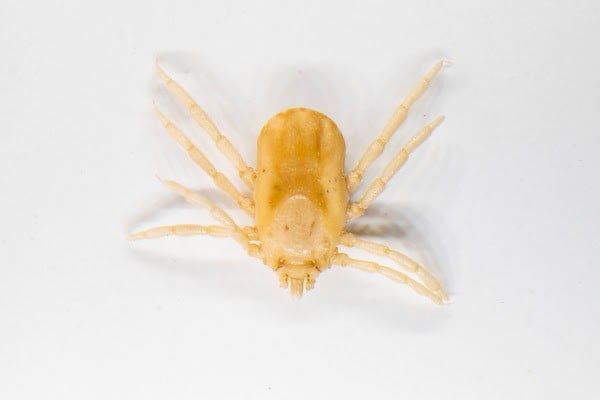Scientists at Texas A&M and the USDA have uncovered the genetic mechanisms that determine whether cattle fever ticks develop as males or females – a breakthrough that could transform how we protect livestock from these dangerous parasites. This foundational research opens new possibilities for controlling ticks that threaten cattle across the globe and cost the agricultural industry billions of dollars annually.
Published in G3: Genes, Genomes, Genetics | Estimated reading time: 8 minutes
Deep in the heart of Texas, where cattle ranching meets cutting-edge science, researchers have unlocked a genetic mystery that could revolutionize how we combat one of the livestock industry’s most persistent threats. This breakthrough emerges from the work of Jason Tidwell, a part-time graduate student in the Texas A&M College of Agricultural and Life Sciences Department of Entomology and full-time microbiologist with the USDA’s Agricultural Research Service Cattle Fever Tick Research Unit at Edinburg.
The gravity of this research becomes clear through the words of Dr. Pete Teel, a Texas A&M AgriLife Research scientist in the Department of Entomology and one of Tidwell’s co-advisors: “These ticks are the only vectors of pathogens causing bovine babesiosis, thus eliminate the ticks and you eliminate the risk of disease.” This straightforward equation – no ticks, no disease – underlies the significance of this genetic breakthrough.
Since 1906, the Cattle Fever Tick Eradication Program has fought to prevent these parasites from reestablishing themselves in the United States. This joint effort between the USDA Animal and Plant Health Inspection Service Veterinary Services and the Texas Animal Health Commission has successfully cleared the ticks from 13 southern states and California. However, a permanent quarantine zone in South Texas stands as testament to the persistence of this threat.
Traditional chemical control methods face mounting challenges as ticks develop resistance to conventional pesticides. This is where genetic control enters the picture. As Tidwell explains, “One idea is to genetically manipulate sex ratios in the environment in ways that prevent reproduction and crash populations of the pest.” This innovative approach has already shown promise in controlling disease-carrying mosquitoes, suggesting similar strategies might work for ticks.
Dr. Kimberly Lohmeyer, center director at the Knipling-Bushland U.S. Livestock Insects Research Laboratory in Kerrville, emphasizes the broader significance of Tidwell’s work: “This study sets the stage for advancements in how we protect U.S. livestock from cattle fever ticks. It answers a basic biological mystery about these ticks, but it is also a big step toward novel tools for the eradication program.”
The current situation is particularly urgent because there are no approved vaccines or therapeutic drugs to treat bovine babesiosis. The eradication program has relied heavily on chemical pesticides, but increasing resistance to these compounds makes new approaches essential.
Looking toward the future, Dr. Aaron Tarone, an AgriLife Research scientist and professor in the Department of Entomology, outlines the next phase of research: “The next step will be building genomes of ticks of local reference from both here in Texas and Mexico to examine their genetic variation. The whole genomics arena and technology associated with it has opened the door to so many possibilities when it comes to dealing with vectors that pose serious threats to human and animal health.”
This genetic breakthrough arrives at a crucial moment in the long battle against cattle fever ticks. For more than a century, ranchers and scientists have fought to keep these parasites at bay. Now, by understanding and potentially manipulating the fundamental mechanisms of tick reproduction, researchers may finally have found a way to turn the tide in this ongoing struggle.
The implications extend far beyond cattle fever ticks. The same genetic control principles could potentially be applied to other disease-carrying ticks, including those that spread Lyme disease in humans. This represents a significant shift in how we approach pest control, moving from chemical warfare to precision genetic intervention – a transformation that could reshape the future of both animal and human health protection.
Key Terms
- Bovine Babesiosis
- A severe disease of cattle, historically known as Texas cattle fever, transmitted by cattle fever ticks. Currently has no approved vaccines or treatments.
- Acaricides
- Chemical pesticides specifically designed to kill ticks and mites, which are becoming less effective as ticks develop resistance.
- Genetic Sex Determination
- The biological mechanisms that control whether an organism develops as male or female, which can potentially be manipulated for population control.
Test Your Knowledge
What makes cattle fever ticks uniquely dangerous to livestock?
According to Dr. Teel, they are “the only vectors of pathogens causing bovine babesiosis,” and eliminating the ticks is the only way to eliminate the disease risk.
What novel approach to tick control does Tidwell’s research suggest?
Tidwell proposes to “genetically manipulate sex ratios in the environment in ways that prevent reproduction and crash populations of the pest.”
According to Dr. Lohmeyer, why is this study significant?
She explains that it “sets the stage for advancements in how we protect U.S. livestock from cattle fever ticks” and represents “a big step toward novel tools for the eradication program.”
What is the next phase of this research, according to Dr. Tarone?
Dr. Tarone states they will be “building genomes of ticks of local reference from both here in Texas and Mexico to examine their genetic variation,” noting that genomics technology has “opened the door to so many possibilities” for dealing with disease vectors.
Enjoy this story? Subscribe to our newsletter at scienceblog.substack.com.

